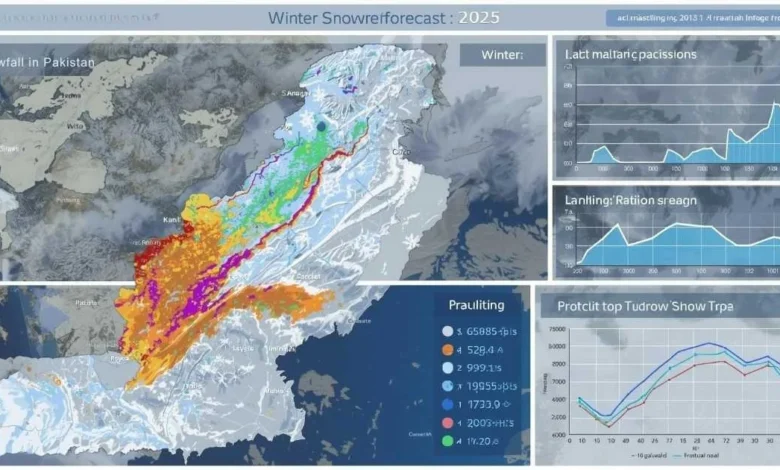Winter Snowfall Forecast for Pakistan in 2025: A Thorough Examination of Climatic Patterns, Regional Impacts, and Future Projections

Introduction: Understanding the Dynamics of Winter Snowfall in Pakistan
Pakistan’s winter weather is intricately shaped by a mix of global and local climatic forces, which together determine the winter snowfall forecast for Pakistan. Given the country’s geographic diversity, winter manifests differently across various regions. While the northern mountain ranges, including Gilgit-Baltistan and Khyber Pakhtunkhwa, experience heavy snowfalls, the plains of Punjab and Sindh remain relatively dry, with colder temperatures.
The year 2025 is poised to bring a more moderate winter, influenced largely by La Niña, a phenomenon that alters oceanic and atmospheric circulation patterns across the globe. This detailed forecast will explore the role of western disturbances, La Niña, and regional topography in shaping the winter snowfall forecast for Pakistan. Additionally, we will examine the broader implications of this forecast on agriculture, tourism, and infrastructure, providing a comprehensive view of what to expect in the coming months.
Key Climatic Influences Affecting Winter Snowfall in Pakistan
Western Disturbances: The Primary Driver of Snowfall in the North
The most significant contributor to winter snowfall in Pakistan is the western disturbance, a system of low-pressure areas that originate over the Mediterranean Sea and move eastward towards South Asia. These disturbances bring moisture from the Mediterranean, and as they move over the landmass, they encounter the Hindu Kush, Karakoram, and Himalayan ranges, where they release the moisture in the form of precipitation, often snow.
- Impact on Snowfall: Western disturbances are primarily responsible for snowfall in the north. They bring significant snowfalls to Gilgit-Baltistan, Khyber Pakhtunkhwa, and Azad Jammu & Kashmir. However, their intensity varies, and the western disturbances‘ strength and frequency are important in determining the winter snowfall forecast for Pakistan each year.
- Snowfall Patterns: These disturbances typically affect the northern regions of Pakistan from November to February, bringing heavy snowfalls in higher altitudes and lighter snow at lower elevations. This year, due to the La Niña effect, western disturbances are expected to be slightly weaker, leading to moderate snowfalls.
La Niña: The Oceanic Phenomenon Shaping Winter Patterns
The La Niña phenomenon, characterized by cooler-than-average sea surface temperatures in the central and eastern Pacific Ocean, plays a crucial role in shaping the winter snowfall forecast for Pakistan. La Niña conditions generally lead to:
- Milder Winters: The cooler ocean temperatures alter the atmospheric pressure systems, reducing the intensity of western disturbances, which in turn results in lesser snowfall. This year’s moderate La Niña event is expected to reduce the snowfall intensity in northern regions, especially in Gilgit-Baltistan and Khyber Pakhtunkhwa.
- Temperature Trends: While La Niña leads to a reduction in precipitation, the temperatures in the affected areas remain relatively cool, although not as extreme as in years with stronger western disturbances. This will bring a milder winter overall.
Geographical and Topographical Factors: How Terrain Affects Snowfall
Pakistan’s diverse geography ensures that winter snowfall is distributed unevenly across the country. The mountainous regions of the north receive heavy snow due to their high altitude and the frequent moisture-laden systems, while the plains of Punjab and Sindh remain relatively dry.
- Northern Regions: The Gilgit-Baltistan, Khyber Pakhtunkhwa, and Azad Jammu & Kashmir regions are particularly vulnerable to heavy snow due to their elevated terrain. These areas are prone to western disturbances and experience significant snowfalls each winter.
- Southern Regions: Punjab, Sindh, and Balochistan experience milder winters, with no snowfall in the plains. However, these regions may still experience cold waves, which cause temperatures to drop significantly but without any snow accumulation.
Winter 2025 Snowfall and Precipitation Predictions: Regional Breakdown
The winter snowfall forecast for Pakistan in 2025 suggests that some regions will experience moderate snowfall, while others will remain largely unaffected. Given the La Niña influence, the snowfalls are expected to be less intense than usual. Below is a detailed regional analysis of the forecast.
Table 1: Regional Snowfall Forecast for Winter 2025
| Region | Expected Snowfall | Temperature Trends | Precipitation Forecast | Impacts |
|---|---|---|---|---|
| Gilgit-Baltistan | Moderate to heavy | Slightly above average | Near normal | Significant snowfalls in high-altitude regions. Tourism and water resources will benefit. |
| Khyber Pakhtunkhwa | Light to moderate | Slightly above average | Near normal | Snow expected in higher altitudes like Swat and Malam Jabba; lower regions remain snow-free. |
| Azad Jammu & Kashmir | Light to moderate | Slightly above average | Below normal | Reduced snowfalls in higher altitudes; snow-free valleys like Muzaffarabad. |
| Punjab | Snow-free | Slightly colder | Below normal | No snow expected, cold spells likely in northern regions like Murree. |
| Sindh | Snow-free | Mild cold waves | Below normal | No snow expected, but mild cold waves may reduce temperatures at night. |
| Balochistan | Very light snowfall | Slightly colder | Below normal | Light snowfall possible in high-altitude areas like Quetta. Lower altitudes will stay dry. |
| Islamabad | Light snowfall | Cold with occasional rains | Below normal | Light snow possible in higher regions of Margalla Hills, occasional rain in the capital city. |
Detailed Regional Snowfall Predictions for Winter 2025
1. Gilgit-Baltistan: A Region of Heavy Snowfall and Tourism Appeal
Gilgit-Baltistan is one of Pakistan’s most snow-prone regions, with its vast mountains and valleys experiencing moderate to heavy snowfall each year. In 2025, moderate snowfalls are expected in Hunza, Skardu, and the Karakoram Range.
- Snowfall Predictions: Areas like Skardu and Hunza will experience moderate to heavy snow, particularly in January and February, the peak of the winter season. The snow in the higher-altitude regions may accumulate several feet.
- Temperature Trends: Temperatures will average -5°C at night, with daytime highs around 5-8°C in the valleys. Higher altitudes will experience sub-zero temperatures.
- Impact on Agriculture and Tourism: Snowfall will help fill water reservoirs, benefiting the agriculture sector, but may also disrupt transportation to remote areas. Tourism will benefit as the region becomes a hotspot for winter sports and snow trekking.
2. Khyber Pakhtunkhwa: Light to Moderate Snowfall in Higher Regions
In Khyber Pakhtunkhwa, snowfall is expected in Swat, Malam Jabba, and Chitral, with the lower areas like Peshawar and Mardan experiencing no snow.
- Snowfall Predictions: Light to moderate snow is expected in Swat Valley, Malam Jabba, and Naran, with the higher elevations seeing more snow. The overall snowfall will be less intense due to La Niña.
- Temperature Trends: The region will experience cooler-than-average temperatures, with highs of 5-7°C during the day and sub-zero temperatures at night in higher altitudes.
- Impact on Infrastructure: Snowfall in areas like Malam Jabba may impact road access, but it will also provide a boost to winter tourism.
3. Azad Jammu & Kashmir: Mild Snowfall Expected in the Higher Reaches
Azad Jammu & Kashmir is known for its beautiful mountain ranges, and this year, snowfall will be moderate due to reduced western disturbances.
- Snowfall Predictions: Areas like Neelum Valley and Bagh will receive moderate snow in January and February, but the valleys will remain snow-free.
- Temperature Trends: Temperatures will hover between 2°C and 8°C in the lower regions, with colder conditions in the mountains.
- Impact on Connectivity: Heavy snow in higher altitudes may cause temporary road closures but will not significantly impact the broader region.
4. Punjab and Sindh: Cold Waves Without Snowfall
While Punjab and Sindh will experience mild winters, no snowfall is expected. However, cold waves may make temperatures drop at night, especially in northern Punjab.
- Punjab: Murree might receive light snow, but the rest of Punjab will remain snow-free. The average winter temperature will be between 5°C to 15°C.
- Sindh: Sindh will see cooler temperatures, with average highs of 15°C and lows of 10°C, but no snow.
- Impact on Agriculture: Punjab may experience frost damage to sensitive crops like wheat. Sindh will remain largely unaffected by winter conditions.
Conclusion: A Milder Winter with Varied Regional Impacts
The winter snowfall forecast for Pakistan in 2025 indicates a milder winter across most of the country. While northern regions like Gilgit-Baltistan, Khyber Pakhtunkhwa, and Azad Jammu & Kashmir will receive moderate snowfalls, southern regions like Punjab and Sindh will remain largely unaffected by snow, with only mild cold waves expected. The influence of La Niña will ensure that snowfall intensity in the north is lower than in previous years.
The forecast suggests significant implications for tourism, with Gilgit-Baltistan and Khyber Pakhtunkhwa benefiting from winter sports tourism. On the other hand, agriculture in Punjab may suffer from cold spells that affect crop growth. Overall, the winter season of 2025 will be a season of moderation, requiring preparation but offering opportunities in the tourism and agriculture sectors.
The winter snowfall forecast for Pakistan highlights the delicate balance between global climatic patterns, regional topography, and local weather systems, which together shape the country’s winter climate.



